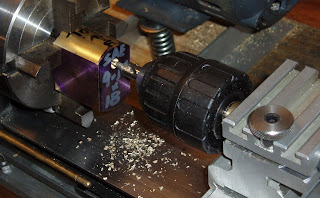
Dave from Radial Grinding was kind enough to supply me with the needed 1.5" diameter brass. Anybody priced brass lately? I need to buy Dave lunch.

After lots of napkin sketches and dragging my feet even more, I decided that the piece was just a bit too long. At full width, this is one heavy piece of metal.

I parted off almost half an inch.

Title this one: Big cut for little lathe.

Crazy. And it worked just dandy. Advancing the cutting blade incrementally in the holder as I cut deeper kept the set-up as stiff as possible.

Faced both ends.

Still wanted (needed?) to take some weight out of the adapter, so I cut a flat.

Without moving the carriage from my final cut, I measured the width of the cut piece in the chuck. Subtracting that from 1.5"--the original diameter of the brass rod told me I'd removed 0.244"--and how much to remove from the opposite side to keep things even.

I touched the stop against the carriage and locked the carriage in place.

Loosened the stop then placed a stack of feeler gauges between the carriage and the stop. The stack of feeler gauges were equal to the 0.244".

Another view.

So the gap to the stop is the depth of the next cut.

Flipped the piece putting the new flat against the chuck.

Then, I just advanced the cut until the carriage bottomed out.

The sides are within just a couple thousandths. Good enough. Next, I did some layout finding the hole locations and depths for the A/S and the 22XX valve thread.

Big markings so I don't do anything (more) stupid (than usual).

After endless centering on the punch mark , I finally spotted the hole for the 9/16-18 valve threads.

Gradually drilled...

...then bored to 0.515"--my tapping size.

Without disturbing the set up in the chuck, I tapped the 9/16-18 thread.

Note the work piece's offset in the 4-jaw. Couldn't turn at anything but the very slowest speed otherwise the vibration got ugly. Could've used a steel or brass packing block to act as a counterbalance--that might have allowed faster turning speeds--but this worked. Just barely.

Threads cut

Still keeping the set-up intact, I bored the relief for an o-ring seat. Matched the original dimensions used by Crosman on the 22XX valve.

One down, one more hole (two actually) to go.

Here's the centering procedure I mentioned above. With a pointed center indicator in the tailstock, the work is adjusted in the 4-jaw and rotated by hand until the center punch has no perceptible run out under magnification.
I'm set up to start the A/S threading next time around.
0 comments:
Post a Comment